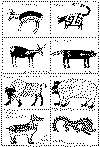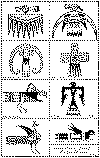By Ernest Thompson Seton

Fig. 78
To admire any special or well-marked school of art, and feel the desire to produce works of similar kind, presupposes a taste cultivated in that direction; for all of the well-known schools have developed artists of the highest merit, and no one can say that this or that is better. All he can say is that this or that school is more to his taste. Just so, a specialist in chrysanthemums cannot reasonably say to a specialist in orchids: "All chrysanthemums are better than all orchids," etc.
At best, one can claim only that each peculiar or national school has its own viewpoint or approach, and its own standards of excellence, as surely as each has evolved its own medium of expression.
Leaving sculpture for consideration in a later issue, the pictorial art of the North American Indian has these well-marked characteristics:
(a) It is, first of all and all the time, decorative. Although at times mnemonic as well as decorative, the beautification of weapon, tepee, or blanket was the motive thought.
The Italian masters made paintings that were to be seen as paintings only; that had relation to life and thought or religious emotion, but not necessarily to the wall of a house, the trappings of a saddle, or the fringe of a robe.
(b) The art of the Redman was never realistic, but always largely symbolic, and dealt in many conventional figures and designs that were not self-explanatory. He never painted the likeness of a buffalo, but always the symbol of a buffalo, with purely conventional symbols of life and sex added.
(c) The art of the Redman was extremely simple. It recognized only two dimensions; and was, in its purest presentation, at nearly the same stage as the Gobelin tapestries and Persian rugs of their earliest, unsophisticated--and best--era.
(d) The art of the Redman found its most joyful esthetic pleasure in color--not in form, not in line, not in groupings, but in color, more or less abstract.

Fig. 79
The materials in which the Redman's art found expression were: paint on skin or wood or pottery; shell work; porcupine quills; sand paintings; engraving on metal or shell or wood. The nature of the material, with the traditional forms of decoration, imposed naturally the limits and characteristics of Indian art.
On account of its association with outdoor life in America, and its agreement with American traditions, as well as its artistic soundness, Indian art is at once turned to by those of our people who would go a-camping, and carry the atmosphere of the days of romance.
There are two well-known ways of acquiring the vocabulary of a new art. One is by following the motivating thought from the ground up, expressing it in the materials that were the original equipment of its artist; the other, the simpler method (and really the only one practical today for Indian art), is by copying good, authentic examples until you have acquired the style--mastered the vocabulary. These should be exactly copied, without variation, until the manner has been sufficiently acquired; otherwise, the danger of realistic violets tied with a beautiful pink ribbon, is apt to obtrude and do its poisonous work.
It is well to remember that examples may be ancient and authentic, yet not good; therefore, great care has been exercised to select specimens that are good art as well as authentic.